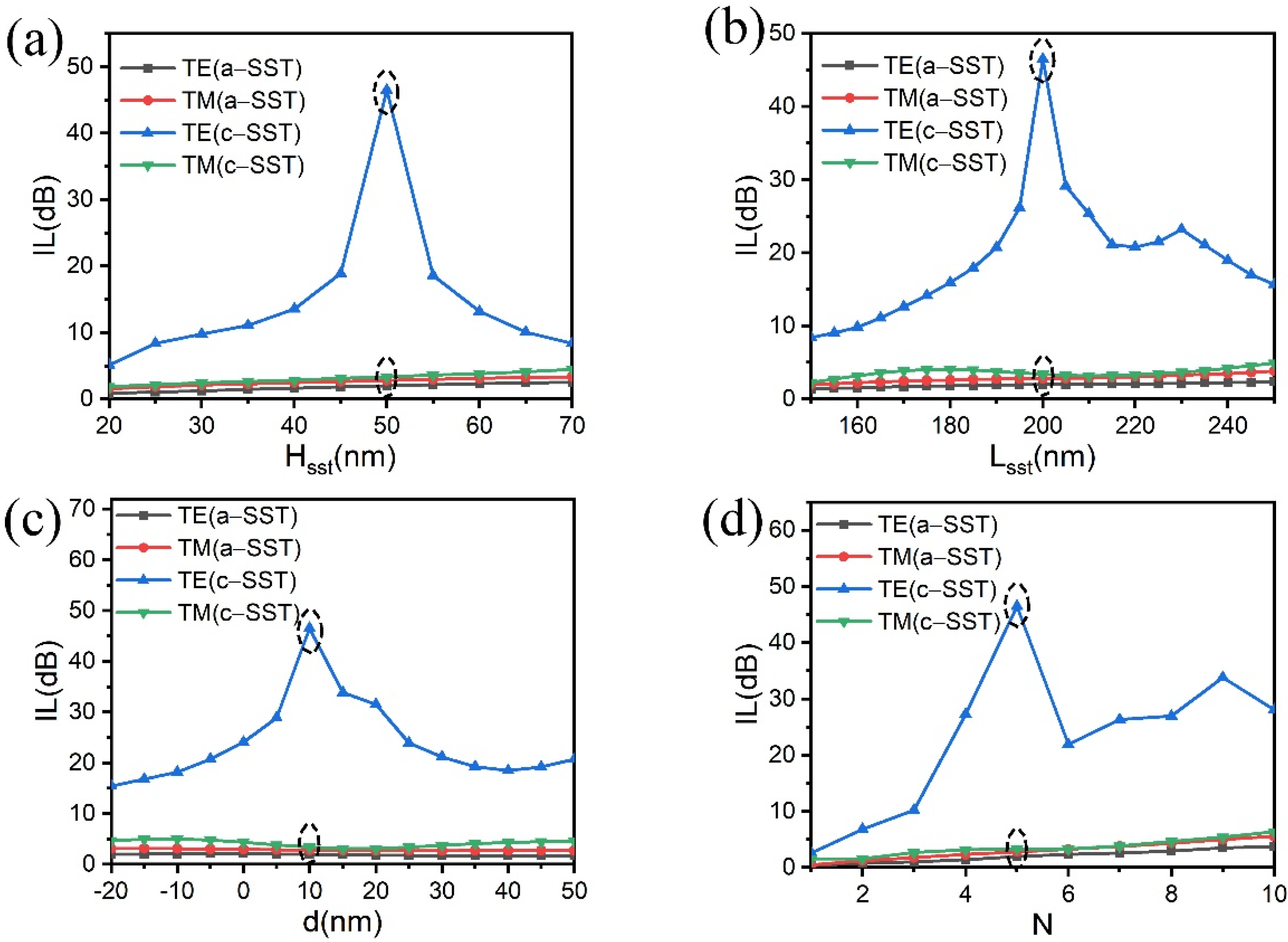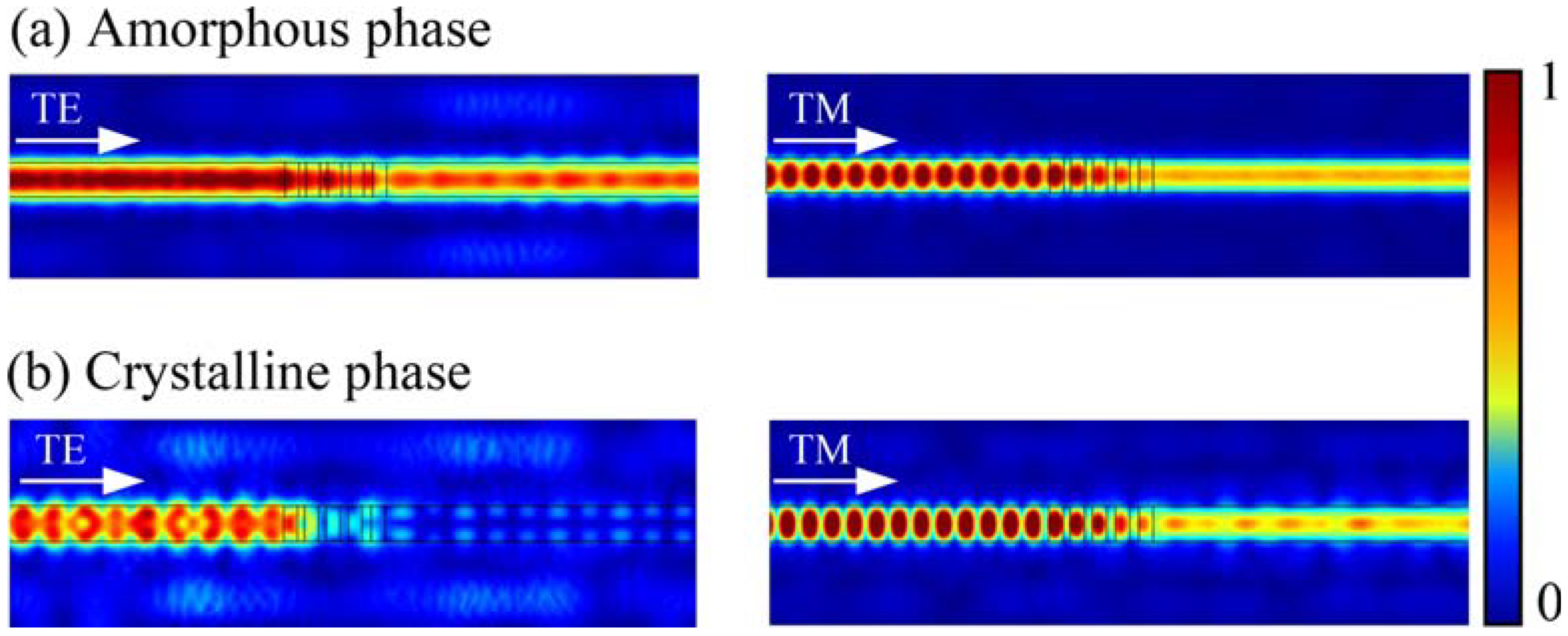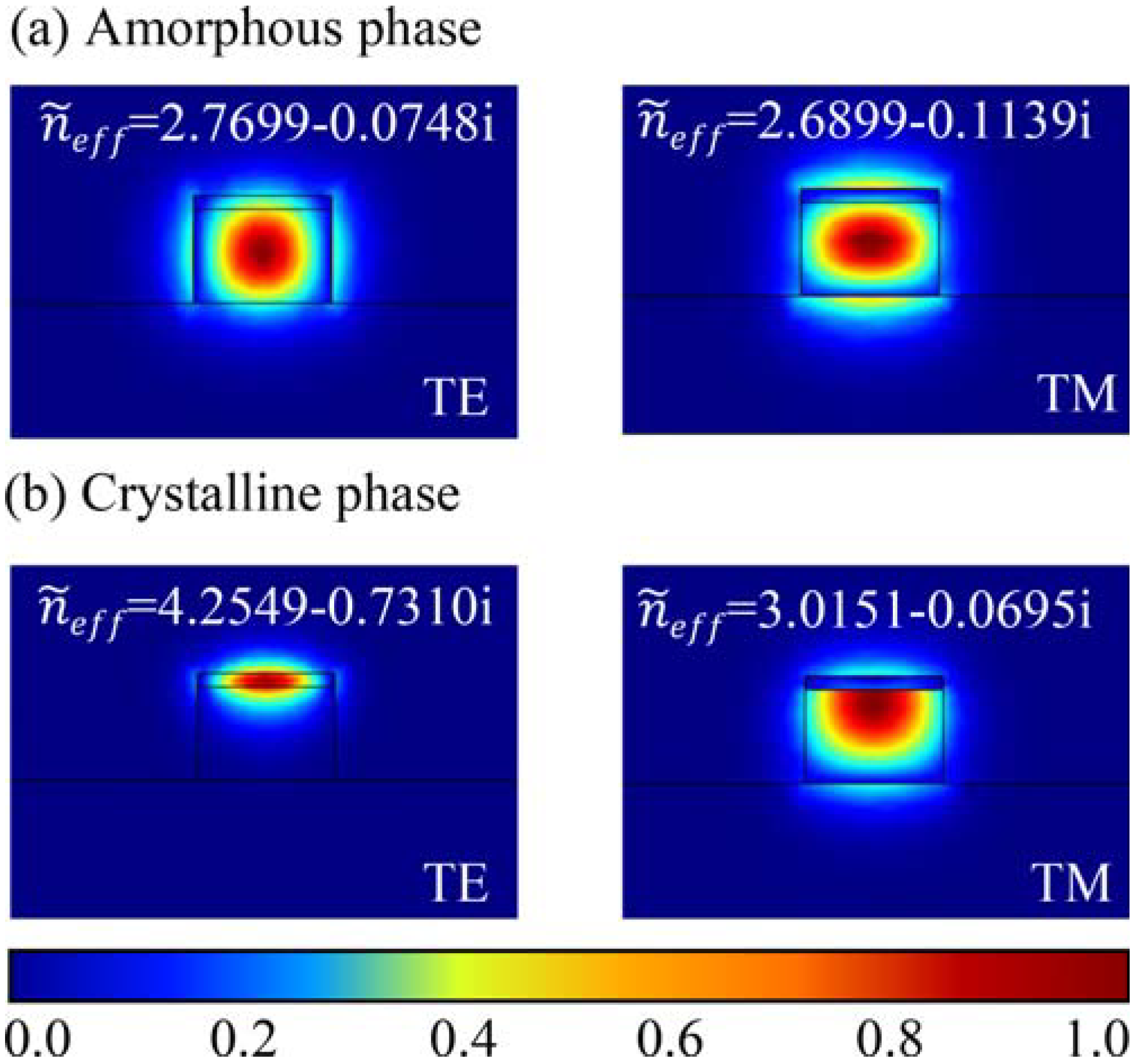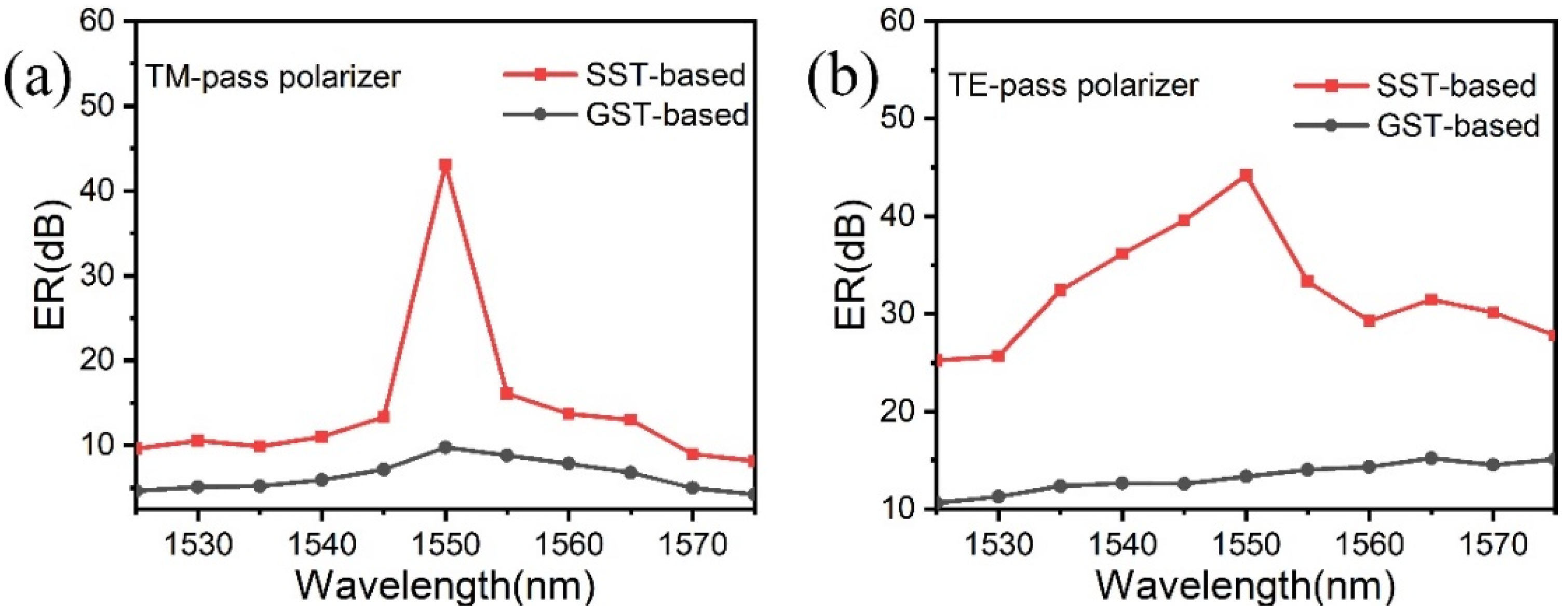Design of Ultra-High Extinction Ratio TM- and TE-Pass Polarizers Based on Si-Sc0.2Sb2Te3 Hybrid Waveguide
Abstract
:1. Introduction
2. Simulation Methods
2.1. Device Structure and Design
2.2. Light Propagation Simulation
2.3. Modal Analysis
3. Result and Discussion
3.1. Optimization of the Structure of the TM-Pass/TE-Pass Polarizers
3.2. Light Propagation Behavior of the TM-Pass/TE-Pass Polarizers
3.3. Modal Analyses
3.4. Comparison with GST-Based TM-/TE-Pass Polarizer
3.5. Discussion
4. Conclusions
Author Contributions
Funding
Data Availability Statement
Acknowledgments
Conflicts of Interest
References
- Xu, H.; Dai, D.; Shi, Y. Silicon Integrated Nanophotonic Devices for On-Chip Multi-Mode Interconnects. Appl. Sci. 2020, 10, 6365. [Google Scholar] [CrossRef]
- Zafar, H.; Flores, R.; Janeiro, R.; Khilo, A.; Dahlem, M.S.; Viegas, J. High-extinction ratio polarization splitter based on an asymmetric directional coupler and on-chip polarizers on a silicon photonics platform. Opt. Express 2020, 28, 22899–22907. [Google Scholar] [CrossRef]
- Li, C.L.; Dai, D.X. Compact polarization beam splitter for silicon photonic integrated circuits with a 340-nm-thick silicon core layer. Opt. Lett. 2017, 42, 4243–4246. [Google Scholar] [CrossRef]
- Dai, D.X.; Wang, Z.; Bowers, J.E. Ultrashort broadband polarization beam splitter based on an asymmetrical directional coupler. Opt. Lett. 2011, 36, 2590–2592. [Google Scholar] [CrossRef]
- Liu, X.; Liu, D.; Dai, D. Silicon polarization beam splitter at the 2 μm wavelength band by using a bent directional coupler assisted with a nano-slot waveguide. Opt. Express 2021, 29, 2720–2726. [Google Scholar] [CrossRef] [PubMed]
- Caspers, J.N.; Alam, M.Z.; Mojahedi, M. Compact hybrid plasmonic polarization rotator. Opt. Lett. 2012, 37, 4615–4617. [Google Scholar] [CrossRef]
- Xu, H.; Shi, Y. Ultra-broadband silicon polarization splitter-rotator based on the multi-mode waveguide. Opt. Express 2017, 25, 18485–18491. [Google Scholar] [CrossRef] [PubMed]
- Xiao, J.; Xu, Y.; Wang, J.; Sun, X. Compact polarization rotator for silicon-based slot waveguide structures. Appl. Opt. 2014, 53, 2390–2397. [Google Scholar] [CrossRef]
- Xu, H.; Shi, Y. On-Chip Silicon TE-Pass Polarizer Based on Asymmetrical Directional Couplers. IEEE Photonics Technol. Lett. 2017, 29, 861–864. [Google Scholar] [CrossRef]
- Wu, S.; Hao, J.; Zhao, Z.; Yao, X.S. Low loss and high extinction ratio all-silicon TM-pass polarizer with reflection removal enabled by contra-mode conversion Bragg-gratings. Opt. Express 2021, 29, 27640–27652. [Google Scholar] [CrossRef]
- Sánchez, L.; Lechago, S.; Sanchis, P. Ultra-compact TE and TM pass polarizers based on vanadium dioxide on silicon. Opt. Lett. 2015, 40, 1452–1455. [Google Scholar] [CrossRef] [PubMed] [Green Version]
- Zhang, X.; Li, Y.; Fan, L.; Peng, C.; Wu, Y.; Zou, M.; Zhao, W.; Li, J.; Zhuang, J.; Yan, J.; et al. Design and simulation of tunable TE and TM pass polarizers based on VO2/Si hybrid waveguide. Opt. Commun. 2022, 502, 127413. [Google Scholar] [CrossRef]
- Song, Y.P.; Xu, P.P. Design of ultra-low insertion loss active transverse electric-pass polarizer based Ge2Sb2Te5 on silicon waveguide. Opt. Commun. 2018, 426, 30–34. [Google Scholar] [CrossRef]
- Sanchez, L.D.; Olivares, I.; Parra, J.; Menghini, M.; Homm, P.; Locquet, J.P.; Sanchis, P. Experimental demonstration of a tunable transverse electric pass polarizer based on hybrid VO2/silicon technology. Opt. Lett. 2018, 43, 3650–3653. [Google Scholar] [CrossRef]
- Briggs, R.M.; Pryce, I.M.; Atwater, H.A. Compact silicon photonic waveguide modulator based on the vanadium dioxide metal-insulator phase transition. Opt. Express 2010, 18, 11192–11201. [Google Scholar] [CrossRef]
- Ryckman, J.D.; Hallman, K.A.; Marvel, R.E.; Haglund, R.F.; Weiss, S.M. Ultra-compact silicon photonic devices reconfigured by an optically induced semiconductor-to-metal transition. Opt. Express 2013, 21, 10753–10763. [Google Scholar] [CrossRef]
- Miller, K.J.; Hallman, K.A.; Haglund, R.F.; Weiss, S.M. Silicon waveguide optical switch with embedded phase change material. Opt. Express 2017, 25, 26527–26536. [Google Scholar] [CrossRef]
- Yamada, N.; Ohno, E.; Akahira, N.; Nishiuchi, K.; Nagata, K.; Takao, M. High speed overwritable phase change optical disk material. Jpn. J. Appl. Phys. Part 1—Regul. Pap. Short Notes Rev. Pap. 1987, 26, 61–66. [Google Scholar] [CrossRef]
- Yamada, N.; Ohno, E.; Nishiuchi, K.; Akahira, N.; Takao, M. Rapid-phase transitions of GeTe-Sb2Te3 pseudobinary amorphous thin films for an optical disk memory. J. Appl. Phys. 1991, 69, 2849–2856. [Google Scholar] [CrossRef]
- Zhang, H.Y.; Zhou, L.J.; Xu, J.; Wang, N.N.; Hu, H.; Lu, L.J.; Rahman, B.M.A.; Chen, J.P. Nonvolatile waveguide transmission tuning with electrically-driven ultra-small GST phase-change material. Sci. Bull. 2019, 64, 782–789. [Google Scholar] [CrossRef] [Green Version]
- Pernice, W.H.P.; Bhaskaran, H. Photonic non-volatile memories using phase change materials. Appl. Phys. Lett. 2012, 101, 4. [Google Scholar] [CrossRef]
- Loke, D.; Lee, T.H.; Wang, W.J.; Shi, L.P.; Zhao, R.; Yeo, Y.C.; Chong, T.C.; Elliott, S.R. Breaking the Speed Limits of Phase-Change Memory. Science 2012, 336, 1566–1569. [Google Scholar] [CrossRef] [Green Version]
- Burr, G.W.; Breitwisch, M.J.; Franceschini, M.; Garetto, D.; Gopalakrishnan, K.; Jackson, B.; Kurdi, B.; Lam, C.; Lastras, L.A.; Padilla, A.; et al. Phase change memory technology. J. Vac. Sci. Technol. B 2010, 28, 223–262. [Google Scholar] [CrossRef] [Green Version]
- Zhang, H.Y.; Zhou, L.J.; Rahman, B.M.A.; Wu, X.; Lu, L.J.; Xu, Y.H.; Xu, J.; Song, J.C.; Hu, Z.G.; Xu, L.P.; et al. Ultracompact Si-GST Hybrid Waveguides for Nonvolatile Light Wave Manipulation. IEEE Photonics J. 2018, 10, 1–10. [Google Scholar] [CrossRef]
- Li, X.; Youngblood, N.; Ríos, C.; Cheng, Z.; Wright, C.D.; Pernice, W.H.P.; Bhaskaran, H. Fast and reliable storage using a 5 bit, nonvolatile photonic memory cell. Optica 2019, 6, 1–6. [Google Scholar] [CrossRef]
- Lankhorst, M.H.R.; Ketelaars, B.; Wolters, R.A.M. Low-cost and nanoscale non-volatile memory concept for future silicon chips. Nat. Mater. 2005, 4, 347–352. [Google Scholar] [CrossRef] [PubMed]
- Xu, P.P.; Lu, Y.G.; Yu, Z.H.; Dai, S.X. Ultra-Compact Active TE and TM Pass Polarizers Based on Ge2Sb2Te5 in Silicon Waveguide. IEEE Photonics Technol. Lett. 2016, 28, 2697–2700. [Google Scholar] [CrossRef]
- Alam, M.; Aitchsion, J.S.; Mojahedi, M. Compact hybrid TM-pass polarizer for silicon-on-insulator platform. Appl. Opt. 2011, 50, 2294–2298. [Google Scholar] [CrossRef]
- Rao, F.; Ding, K.Y.; Zhou, Y.X.; Zheng, Y.H.; Xia, M.J.; Lv, S.L.; Song, Z.T.; Feng, S.L.; Ronneberger, I.; Mazzarello, R.; et al. Reducing the stochasticity of crystal nucleation to enable subnanosecond memory writing. Science 2017, 358, 1423–1426. [Google Scholar] [CrossRef] [Green Version]
- Chen, B.; Chen, Y.M.; Ding, K.Y.; Li, K.L.; Jiao, F.Y.; Wang, L.; Zeng, X.R.; Wang, J.Q.; Shen, X.; Zhang, W.; et al. Kinetics Features Conducive to Cache-Type Nonvolatile Phase-Change Memory. Chem. Mat. 2019, 31, 8794–8800. [Google Scholar] [CrossRef]
- Zewdie, G.M.; Zhou, Y.X.; Sun, L.; Rao, F.; Deringer, V.L.; Mazzarello, R.; Zhang, W. Chemical Design Principles for Cache-Type Sc-Sb-Te Phase-Change Memory Materials. Chem. Mat. 2019, 31, 4008–4015. [Google Scholar] [CrossRef] [Green Version]
- Xu, Z.; Lyu, T.; Sun, X. Interleaved Subwavelength Gratings Strip Waveguide Based TM Pass Polarizer on SOI Platform. IEEE Photonics J. 2020, 12, 1–10. [Google Scholar] [CrossRef]
- Yu, W.; Dai, S.; Zhao, Q.; Li, J.; Liu, J. Wideband and compact TM-pass polarizer based on hybrid plasmonic grating in LNOI. Opt. Express 2019, 27, 34857–34863. [Google Scholar] [CrossRef] [PubMed]
- Li, X.; Youngblood, N.; Cheng, Z.G.; Carrillo, S.G.C.; Gemo, E.; Pernice, W.H.P.; Wright, C.D.; Bhaskaran, H. Experimental investigation of silicon and silicon nitride platforms for phase-change photonic in-memory computing. Optica 2020, 7, 218–225. [Google Scholar] [CrossRef]
- Duan, H.; Hu, H.; Kumar, K.; Shen, Z.; Yang, J.K.W. Direct and Reliable Patterning of Plasmonic Nanostructures with Sub-10-nm Gaps. Acs Nano 2011, 5, 7593–7600. [Google Scholar] [CrossRef]
- Huang, Y.; Liu, F.; Zhang, Y.; Li, W.; Han, G.; Sun, N.; Liu, F. Effects of biaxial strain on interfacial intermixing and local structures in strain engineered GeTe-Sb2Te3 superlattices. Appl. Surf. Sci. 2019, 493, 904–912. [Google Scholar] [CrossRef]
- Chen, C.H.; Pang, L.; Tsai, C.H.; Levy, U.; Fainman, Y. Compact and integrated TM-pass waveguide polarizer. Opt. Express 2005, 13, 5347–5352. [Google Scholar] [CrossRef] [Green Version]
- Liu, Y.; Huang, X.R.; Li, Z.Z.; Kuang, Y.X.; Guan, H.; Wei, Q.Q.; Fan, Z.C.; Li, Z.Y. TE/TM-pass polarizers based on lateral leakage in a thin film lithium niobate-silicon nitride hybrid platform. Opt. Lett. 2020, 45, 4915–4918. [Google Scholar] [CrossRef]









Publisher’s Note: MDPI stays neutral with regard to jurisdictional claims in published maps and institutional affiliations. |
© 2022 by the authors. Licensee MDPI, Basel, Switzerland. This article is an open access article distributed under the terms and conditions of the Creative Commons Attribution (CC BY) license (https://creativecommons.org/licenses/by/4.0/).
Share and Cite
Xie, X.; Liu, F.; Chen, Q.; Zhang, Y. Design of Ultra-High Extinction Ratio TM- and TE-Pass Polarizers Based on Si-Sc0.2Sb2Te3 Hybrid Waveguide. Micromachines 2022, 13, 495. https://doi.org/10.3390/mi13040495
Xie X, Liu F, Chen Q, Zhang Y. Design of Ultra-High Extinction Ratio TM- and TE-Pass Polarizers Based on Si-Sc0.2Sb2Te3 Hybrid Waveguide. Micromachines. 2022; 13(4):495. https://doi.org/10.3390/mi13040495
Chicago/Turabian StyleXie, Xuanxuan, Furong Liu, Qingyuan Chen, and Yongzhi Zhang. 2022. "Design of Ultra-High Extinction Ratio TM- and TE-Pass Polarizers Based on Si-Sc0.2Sb2Te3 Hybrid Waveguide" Micromachines 13, no. 4: 495. https://doi.org/10.3390/mi13040495
APA StyleXie, X., Liu, F., Chen, Q., & Zhang, Y. (2022). Design of Ultra-High Extinction Ratio TM- and TE-Pass Polarizers Based on Si-Sc0.2Sb2Te3 Hybrid Waveguide. Micromachines, 13(4), 495. https://doi.org/10.3390/mi13040495






